
More efficient movement in Tennis
This game of tennis provides a continuing array of challenges. Mastering the nuances of grips and how they influence strokes. Learning to vary ones tempo, spin and ball placement. Getting the knack of anticipation and how it influences strategy. Learning the importance of the score, and when the so called “big points occur” and equally important, learning how to play these “big points” well.
And always there is the issue of footwork. Are your steps slow, hurried, or on time? Are your steps quiet, or do your shoes make a lot of noise? When arriving to stroke the ball, how are you positioned? Footwork truly is the name of the game. But before anything else regarding the feet, the first move, your initiating sequence will influence all that follows.
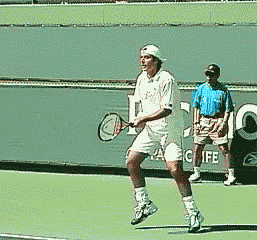 There are many potential sequences – is it feet first then the body? Is it body leaning first and then the feet follow? And what of the hips, do you move and then turn or turn and then move? Lets answer these questions about how to start by looking at the role of the hips.
There are many potential sequences – is it feet first then the body? Is it body leaning first and then the feet follow? And what of the hips, do you move and then turn or turn and then move? Lets answer these questions about how to start by looking at the role of the hips.
There are perhaps three scenarios here, with as many as eight permutations. First, when moving (and we will always presume forehand in the following) are your hips facing the net or have they turned to face the ball (first scenario)?
If your hips turn, do the feet initiate and then the hips subsequently turn, or do the hips turn and then the feet follow (second scenario). Which foot moves first, and where (third scenario) ? That is, does the right foot step out toward the ball, does the right foot pivot and the left foot crossover to the ball, or does the right foot pivot as it moves away from the ball?
As a teacher I observe some players move smoothly, others appear to hop up and down as they move to the ball. Some players move quickly, others move with a labored manner. Some players move in an upright style, others tilt and lean as they run. Finally, these issues are amplified when players must move either greater distances, or when they must move quickly – certainly there must be a “key” here somewhere.
Efficient movement on a tennis court is about both quickness and effort, but only when one is maximized (quickness) and the other minimized (effort) is the movement truely efficient. Quick movement with minimum effort is known as agility.
Study the most agile players and you will notice the first thing to move after the split step is the opening of the hip and the firing of the hip rotators. Once this mechanism is understood, players can improve both balance and movement.
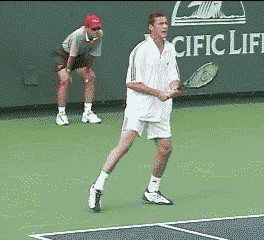 Note: the hip opens before any other movement takes place. This is the "A" in the sequence of efficient movement.
Note: the hip opens before any other movement takes place. This is the "A" in the sequence of efficient movement.
Andre Agassi has remarked, “All I try to do on return of serve is get my hips to move to the forehand or backhand, and then everything follows.” And in fact, this “hip opening” is the key (perhaps the only key) to an effective return of serve.
Although many players may in fact make this move naturally, you may find court areas or situations where this move may be improved. As with anything in tennis, once a concept is clearly understood it is more readily learned. Let us firstly examine the return of serve
Return of Serve
Notice Marat Safin's footwork on the return of serve. After the split step Safin initiates the unit turn.
At speed, it may look like both feet pivot together, but slowed down, you can see his right foot pivots first allowing him to open the right hip for easy movement to his forehand return.
Below, Lleyton Hewitt utilizes the same movement on the backhand side, first pivoting the left foot allowing him to open the left hip for the backhand return.
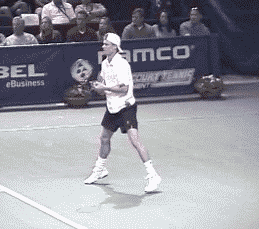 If the serve comes into the body, most top players engage the pelvis and skip either left or right to create the space needed to make the return so the opening of the hip is less pronounced or noticeable.
If the serve comes into the body, most top players engage the pelvis and skip either left or right to create the space needed to make the return so the opening of the hip is less pronounced or noticeable.
Retreating (Drop step)
Retreating towards the corner for a deep floater presents a real movement challenge. Some players only half open the hip with a foot pointing parallel to the sideline, and in this instance the player will move with a hopping gait, shuffling quickly with their head and eyes bobbing up and down.
Opening the hip and foot with a drop step towards the corner of the back fence gives the player both increased power of movement, speed, and greater ability to push off the ground if they load enough weight onto the retreating leg. Explosive ground force allows the player to release the pressure often jumping and rotating into the air to play the shot.
It is equally important for the player to land with a wide base after the shot is played so that balance is not lost backwards forcing a greater loss of court position than necessary and generally a weaker shot.
As you experiment with this move, monitor your level of effort and the distance you can cover, noting whether you begin to glide (as one would hope) and also noting whether your vision improves when you cease hopping (again, a desired result).
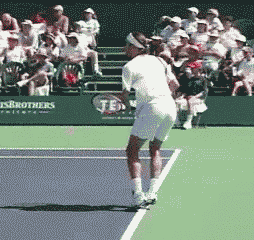 Opening the hip and foot with a jab step towards the left corner of the back fence for the defensive backhand gives the player both increased power of movement and speed.
Opening the hip and foot with a jab step towards the left corner of the back fence for the defensive backhand gives the player both increased power of movement and speed.
Note the angle, width, and stacking of the weight with Roger Federer's forehand drop step.
Playing Volleys Off a Ball into the Body
Hitting volleys with a narrow base causes the shoulders to swivel backwards to make space leading to a loss of balance. The left leg then must step back to compensate for this loss of balance.
When a player opens the hip and swivels the pelvis using a wide base on a forehand or backhand volley into the body, both the weight of the shot and the balance is maintained and recovery will be more efficient for the next volley.
Note that there is minimal movement in the shoulders and no ground is lost. In fact there is a slight pushing forward as the weight transfers across.
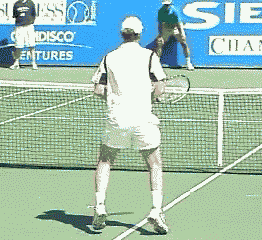 On the right, John McEnroe demonstrates the first movement on the volley after the split, the opening of the hip. This allows the stacking of weight and the ability to push powerfully forward into the volley.
On the right, John McEnroe demonstrates the first movement on the volley after the split, the opening of the hip. This allows the stacking of weight and the ability to push powerfully forward into the volley.
The Overhead
This is where the rubber meets the road, to borrow a phrase I heard sometime ago. Circling back to get under the ball for an overhead smash is perhaps the most difficult footwork challenge.
At the club level, one typically sees “backpedaling” where the hips and shoulders face the net as the player scuttles in a backward fashion – and if they do arrive (as often they simply cannot move quickly enough to get there with this backpedaling step), their torso and shoulders are poorly positioned for an overhead swing.
The key here, as with the the drop step, when retreating for a deep ball along the baseline is the accurate and full opening of the hips before the feet get you started. Again notice how mcenroe's left foot opens towards the left back fence as he prepares to hit the overhead.
Moving laterally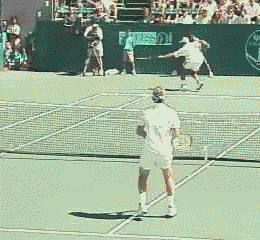 When players move laterally on the baseline the opening of the hip is the same as the return of serve movement.
When players move laterally on the baseline the opening of the hip is the same as the return of serve movement.
To allow a player to move forward in a linear movement the pelvis engages as the player powers forward. This is felt rather than seen with the naked eye.
Understanding the sequence of opening the hip first for any lateral movement can improve the efficiency of most players around the court.
Study the top players in the TennisOne ProStrokes Gallery and you will see first hand both the obvious hip opening or the more subtle hip opening used when players skip or jump into position.
Explaining movement and technique in articles is far more difficult than teaching live and I hope in some small way this article can convey the meaning and importance of this action. Often technique is compromised not by poor swings but rather poor foot placement, which prevent the hip from opening thus causing loss of balance.
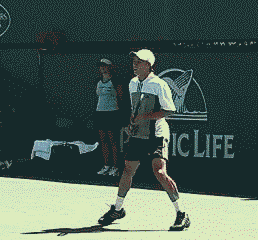 In conclusion, although the pelvic area is the first area that fires in any directional change, there are subtle differences in regards to the subsequent foot placements. These include the so-called ‘step and glide’, pivot, and jab steps but this article has focused on the link between movement and its affect on technique in specific playing situations.
In conclusion, although the pelvic area is the first area that fires in any directional change, there are subtle differences in regards to the subsequent foot placements. These include the so-called ‘step and glide’, pivot, and jab steps but this article has focused on the link between movement and its affect on technique in specific playing situations.
I would like to thank Jez Green, a consummate professional and one of the finest tennis specific fitness trainers in the world for his brilliant contribution to my coaching and his dedication to helping many tennis players to move efficiently.
by David Sammel
Pictures used in this article are courtesy of TennisOne

